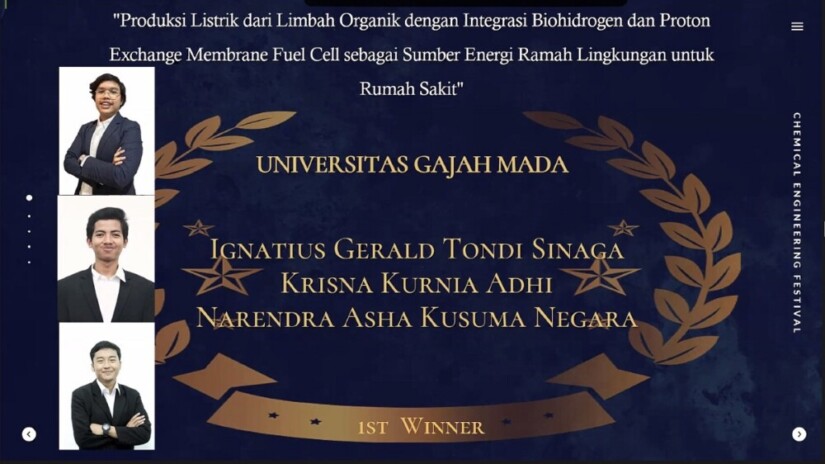
The Proust Team from the UGM Chemical Engineering Study Program consists of Gerald Tondi Sinaga, Krisna Kurnia Adhi, Narendra Asha Kusuma Negara successfully brought home 1st winner award and the Best Presentation of Scientific Paper Competition. This competition was held at the Chemical Engineering Festival by Pertamina University.
This festival is an annual event that was held in four months, starting from November 2020 until February 2021. These competition stages consisted of Abstract Selection, Full Paper, Poster, and the Final Presentation.
Team Proust wrote the scientific papers based on the actual problems during and for the post-pandemic condition of Covid-19. This team has successfully provided a solution for two problems by producing environmentally friendly energy as an electricity source for the hospital.
“We tried to consign organic waste processed by thermophilic bacteria to produce biohydrogen which will be converted using fuel cells that later will produce electricity. Our team presented a short video to visualize the electricity production system and the plant’s physical form at the presentation session. We got a compliment from the judges because of our convincing visualization and the additional creative innovation,” said Gerald on Thursday (15/4).
Gerald considered this competition an intriguing challenge because it addressed sustainable energy problems that are generally overlooked during a pandemic.
“Our team develops an efficient electricity production system that aims to help the electrical supply in the hospital during the pandemic. We are impressed by the jury’s compliment, who is once also an expert in the bioprocess field. He complimented our effort for the by-passing process of methane formation so that the overall efficiency boosts drastically,” he said.
During the selection process, the Proust team had experienced obstruction several times, especially in developing the bioreactor system. According to them, the most challenging hurdle is attaining bacteria that can operate at temperatures high enough to boost the hydrogen rate.
“In the end, we got the bacteria source from the cow dung. Meanwhile, the source for hydrogen production was organic waste. To sum up, we can say that almost our system is from waste which somehow transforms into a benefit in the form of a stable electricity supply,” said Gerald.
He also expected that researchers could further examine this solution to increase this project’s feasibility, both from technical and economical aspects. Researchers can develop the prototype first on a tiny scale to observe the hypothesis that will later catalyze environmentally friendly development for both Indonesia and global.
Author: Desy


